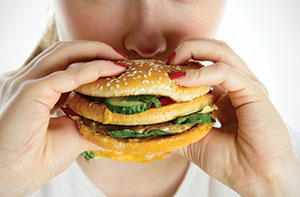Are You Eating More By Eating Less Often?
WHEN WE EAT MORE OFTEN, we can eat fewer calories. Seems counterintuitive, doesn’t it? But the science is fairly simple: When our stomachs are empty, they release hormones that cause us to feel hunger pangs. If you sit down to a meal after hours of battling hunger, you’re more likely to devour your food and eat more of it.
Combine that with a world in which food is everywhere, and you aren’t just eating anymore—you’re feasting. And that’s a recipe for trouble.
 Feasting
Feasting
You’d think eating a bigger meal would leave you feeling fuller, but one of the problems with feasting is that it actually leaves you hungrier.
A study in 2007 took feasting to an extreme and had a group of respondents eat only one large meal per day. Some of them lost weight and others saw their cholesterol numbers worsen, but all of them reported the same “significant increase in hunger”!
Why is that? When your stomach empties, its cells release a hormone called “ghrelin” that causes you to feel hunger pangs. If you’re feasting and fasting, you’re probably getting that ghrelin signal often between meals.
Even if you aren’t in dire need of food, you might find yourself overeating because you’ve been fighting off a ghrelin signal for a few hours.
Complicating the matter, many of the foods we feast on don’t provide a feeling of fullness or satiety. A century ago, many of these foods, at least with their current ingredient lists, didn’t exist.
High fructose corn syrup is abundant in most soft drinks and other processed foods, but research has shown that fructose, sans fiber, doesn’t leave you feeling as satisfied as healthier foods.
Many other foods that aren’t replete with high fructose corn syrup, such as the McDonald’s® Big Mac®, contain trans fats and are laden with salt, making them difficult to set down.
When you’re eating foods that don’t leave you feeling full and you’re spacing your meals out with large, hungry intervals, it’s pretty difficult to avoid eating more than you should.
Consequently, many of us eat the caloric equivalent of a feast two or three times a day, every day.
What’s the difference between a meal and a feast? A good cutoff is around 500 calories. Consider that the aforementioned Big Mac by itself contains 550 calories‡—and that’s without the fries or the soda!
Even if you’re eating at home, how many of your “three square meals a day” exceed 500 calories?
The question is, what is all of this constant feasting doing to us? If you aren’t using those calories right away (and if you are, you probably feel fairly bloated during your workout), your body is storing that energy as fat. When that fat never gets burned off, a whole host of health complications ensue, including heart disease, cancers, and diabetes.
 3 Meals, 2 Snacks
3 Meals, 2 Snacks
So how can you balance hunger and satiety without overeating? One key for warding off those hungry feelings is to transition your eating habits to three medium-sized meals (think 400 calories) and two smaller snacks (150 calories or less) per day. Divide your day into manageable time spaces between meals rather than fasting and then gorging.
How does that help? Studies have shown more frequent meals can reduce LDL cholesterol and insulin spikes.
Insulin, the hormone that gives your body the signal to clear sugar from the blood and store energy (in the form of fat), plays a key role in the development of type II diabetes. If your body becomes “insulin-resistant,” your cells stop responding to that persistent signal from insulin, and sugar remains in your blood instead of being absorbed or stored. Insulin also prevents your body from using fat as an energy source, making weight loss nearly impossible.
In addition to smoothing out insulin spikes, the idea behind eating more frequently is to eat fewer total calories without seeing a big increase in hunger. If you’re transitioning from eating three square meals only, you’ll need to make sure that you’re actually eating fewer calories and not just splitting those calories between five meals—or worse, eating more calories by adding more eating opportunities.
If you’re hoping to lose weight by eating more meals per day, you’ll want to start by approximating your daily caloric needs each day—eat just enough to maintain your weight and no more. Eventually, you’ll want to transition to a calorie deficit—eating fewer calories than you burn. For more detailed information on how to do this, review your copy of Vitality: Simple Steps to Your Ideal Weight™
Also, when you do eat those meals and snacks, it’s important you include foods that leave you feeling fuller. What sort of foods, you ask? Many foods can fill your stomach, but fiber and protein will leave you with a greater sense of fullness.
Fiber has the additional benefit of slowing your absorption of fructose, which allows your body to tap into fructose as a source of ready-to-use energy rather than storing it as fat.
Melaleuca has many products that can help you get your daily requirement of fiber and protein.
Fiber: one key to fullness
Dietary fiber is nothing more than plant pieces your body can’t digest. Soluble fiber, such as that found in FiberWise® products, can slow the movement of food through your digestive system, keeping your stomach full longer. Insoluble fiber can speed up the flow of food through your digestive system.
While FiberWise can help you enjoy a healthier lifestyle at any time of day, drinking a glass of FiberWise just before dinner can provide benefits that will help you power your weight-loss efforts. It can help you manage the glycemic load from your meal, leaving you more energetic and helping you avoid late-night snacking. Its exclusive formula can also aid in proper digestion and sweep away fat, cholesterol and toxins.*
Breakfast: Kick Your Day Off Right
A number of research studies have correlated skipping breakfast with being overweight, and 78% of the registrants at the National Weight Control Registry (who’ve lost at least 60 pounds and kept it off for years) report being breakfast eaters. Nonetheless, other studies have shown that eating sugary cereals often results in consuming more calories during the day. So what sort of breakfast can get you off to a good start?
Aim for a high-fiber, high-protein breakfast each day. An Attain® GC Control™ shake, for example, provides 9 grams of soluble fiber and 10 grams of protein per serving, and a bowl of Simply Fit™ Whole Oats and Flax Hot Cereal provides 5 grams of fiber and 5 grams of protein. General Mills’ Golden Grahams®, by contrast, gives only 2 grams of fiber and 2 grams of protein as well as 10 grams of sugar.†
Remember: Eating smaller meals and enjoying healthy snacks throughout the day is an effective way to lose weight.
‡ Source: mcdonalds.com*These statements have not been evaluated by the Food & Drug Administration. This product is not intended to diagnose, treat, cure, or prevent any disease.
† Source: growupstrong.com
